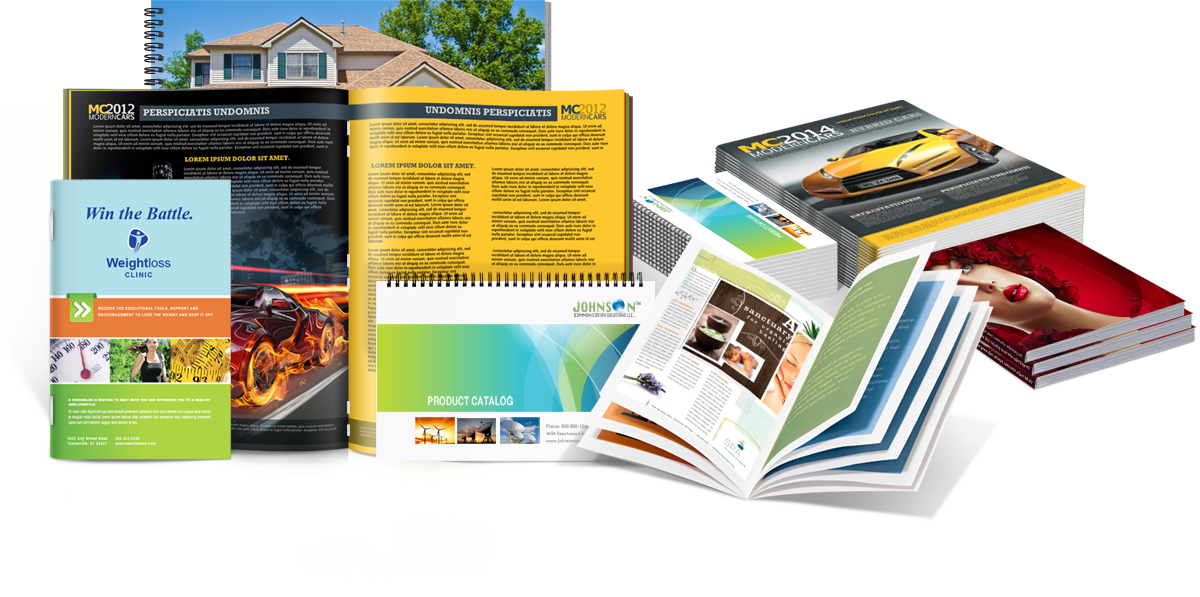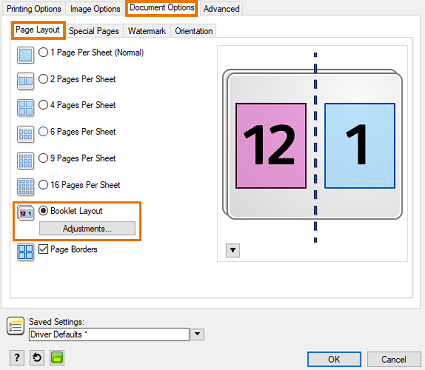7 Must-Know Tips for Affordable Booklet Printing Solutions
7 Must-Know Tips for Affordable Booklet Printing Solutions
Blog Article
The Crucial Guide to Comprehending Booklet Printing Options and Techniques
The process of booklet printing entails multiple factors to consider that can substantially influence the last product. From choosing the proper style and dimension to recognizing the nuances of binding methods, each option plays a vital duty. Additionally, factors such as paper stock and printing methods further affect the efficiency of the booklet. As one navigates these options, it comes to be critical to comprehend exactly how they interconnect and what that means for the total result.
Recognizing Pamphlet Sizes and formats
When taking into consideration booklet printing, comprehending the different layouts and sizes available is important for attaining the preferred presentation. Booklets can be created in various styles, including saddle-stitched, spiral-bound, and perfect-bound, each offering unique advantages. Common sizes vary from standard letter (8.5 x 11 inches) to smaller alternatives like A5 (5.8 x 8.3 inches), enabling adaptability based upon web content and target audience.Selecting the appropriate size can affect both the design and viewers engagement. Larger dimensions might suit visually driven web content, while smaller formats may be more user-friendly and portable. Furthermore, the number of web pages influences the selection of binding method, as thicker brochures might require stronger bindings. Inevitably, recognizing these aspects enables for a much more tailored strategy, ensuring that the final product lines up with the intended message and aesthetic, enhancing the general efficiency of the communication.
Choosing the Right Paper Stock
Binding Techniques: Considerations and choices
When it comes to binding techniques for pamphlets, numerous alternatives are offered, each with distinctive benefits. Saddle stitch binding offers an economical remedy for thinner pamphlets, while perfect binding techniques supply an even more sleek search for thicker publications. Wire-O binding attracts attention for its sturdiness and convenience of use, making it perfect for files that require adaptability.
Saddle Stitch Binding
Saddle stitch binding uses a sensible and economical solution for putting together brochures, making it a prominent selection amongst businesses and authors. This binding approach includes folding sheets of paper in fifty percent and stapling them along the fold line, developing a cool and well organized appearance. Generally appropriate for booklets with a reduced web page count, saddle stitching is optimal for magazines, brochures, and training materials. The simpleness of this strategy permits quick manufacturing and is typically favored for short runs or advertising things. However, it is necessary to note that saddle stitch binding might not be ideal for thicker booklets, as the spinal column may not stand up under raised weight. Overall, it continues to be a trusted choice for numerous printing tasks.
Perfect Binding Methods
Perfect binding is a widely made use of method that provides a sleek and professional finish to pamphlets and publications. This technique involves gluing the web pages together at the spinal column using a strong adhesive, enabling a tidy side and the capability to hold a larger number of pages compared to saddle stitching. Perfect binding is especially suitable for thicker pamphlets, such as brochures and yearly reports, where a strong, level spine is wanted. Additionally, it supplies the option for a printed cover that can be made to boost visual allure. Considerations such as page matter, paper weight, and the planned usage of the pamphlet should be taken into account, as they can impact longevity and overall quality.
Wire-O Binding Options
Wire-O binding, known for its longevity and versatility, provides an exceptional option for pamphlets that call for simple page transforming and a specialist look. This binding method utilizes a series of metal loops that hold pages securely, permitting them to lie flat when open. It is particularly appropriate for brochures, discussions, and handbooks due to its durable nature. Wire-O binding is available in numerous colors and diameters, suiting different page matters and thicknesses. Furthermore, it permits the incorporation of tabs and covers, enhancing the brochure's general aesthetic. Considerations for Wire-O binding include the choice of wire color, the dimension of the loops, and the extent of customization wanted, every one of which can greatly influence the final item's look and functionality.
Digital vs. Offset Printing: Which Is Best for You?
When picking a printing approach for brochures, understanding the distinctions between digital and balance out printing is vital. Digital printing utilizes modern-day technology to produce high-grade prints rapidly and affordably, making it excellent for brief runs or projects requiring quick turnaround times. It permits personalization, providing the capability to print on-demand with very little waste.In contrast, counter printing is a standard method that masters producing big amounts with constant high quality. It involves moving ink from a plate to a rubber covering, after that to the paper, which leads to vivid colors and accurate information. Counter printing commonly needs longer arrangement times and is more economical for larger volumes.Ultimately, the selection between digital and balance out printing depends on job needs, spending plan, and preferred amount. For tiny, time-sensitive projects, digital could be the ideal option, while countered may be more suitable for larger, top notch manufacturings.

Creating Your Brochure: Tips and Finest Practices
When developing a booklet, mindful attention to format, typeface choice, and color use can greatly improve its efficiency. A well-structured design guides the reader's eye, while ideal fonts guarantee readability and share the preferred tone. Furthermore, efficient use of color can evoke feelings and highlight key details, making the overall layout a lot more impactful.
Selecting the Right Layout
Just how can one successfully select the appropriate layout for a pamphlet? First, it is important to evaluate the pamphlet's objective and target market. A tidy, arranged design boosts readability and involvement. Using a grid system can aid in straightening aspects consistently, producing an expert look. Furthermore, integrating visual pecking order through varying sizes and placements of images and message can direct the viewers's eye and highlight essential details. It is likewise vital to leave enough white space, which stops overcrowding and enables for far better focus. Ultimately, testing various designs through mock-ups can supply understanding into exactly how the style does in real-world scenarios, guaranteeing that the last item meets both visual and functional demands.
Picking Ideal Fonts
A well-chosen font can substantially enhance the overall design of a brochure, enhancing the design and strengthening the material's message. The selection of typefaces need to take into consideration readability, particularly for body text, as it guarantees the details is available to all visitors. Sans-serif typefaces are often chosen for electronic layouts, while serif font styles can offer a look at these guys traditional feeling in published products. It's suggested to restrict font options to 2 or 3 to preserve aesthetic comprehensibility. In addition, font dimension plays a crucial duty; headings ought to be distinct however not overwhelming, while body text must fit for reading. When selecting typefaces, placement with the brochure's theme and target market is necessary for reliable communication and visual allure.
Efficient Use Color
Color acts as a powerful device in pamphlet design, forming perceptions and leading visitor feelings. It can evoke sensations of calmness, trust fund, or excitement, depending upon the tones picked. Designers ought to take into consideration color theory concepts, making certain that the selected palette lines up with the booklet's message and target market. Utilizing warm colors like red and orange can develop necessity, while cooler tones like green and blue foster tranquility.Additionally, contrast plays a crucial role; corresponding shades can enhance readability and visual charm. Consistency in color usage throughout pages better reinforces brand name identification and communication. Eventually, reliable shade execution not just records focus yet likewise strengthens the brochure's function, making it a necessary facet of effective style.
Finishing Touches: Coatings and Special Results
While several take into consideration the web content and format of a brochure one of the most crucial elements, the ending up touches, such as coatings and unique impacts, play a necessary role in enhancing its total appeal. Coatings can supply security and sturdiness, making sure that the brochure endures wear and tear. Matte finishes provide an innovative, non-reflective surface area, while shiny finishings can make colors show up more vibrant and attractive. Unique impacts, like embossing or foil marking, include a tactile dimension that can develop a remarkable perception. These techniques can highlight details areas, drawing focus to essential information or producing visual passion. Additionally, UV layer can supply a high-shine finish that raises the overall look.Together, these completing touches not just enhance the pamphlet's aesthetic yet also connect professionalism and trust and attention to information, ultimately leaving a long lasting impact on the viewers.
Price Considerations for Booklet Printing
Recognizing the numerous cost considerations for pamphlet printing is important for organizations and organizations intending to maximize their budgets. Secret variables affecting costs include the selection of ink, paper, and binding approaches. Better materials, such as superior paper or specialized inks, typically enhance the general expenditure. In addition, the size and page count of the pamphlet play a substantial role; larger booklets need more resources and time to produce.Another essential factor to consider is the printing strategy, whether electronic or countered, as each has its very own rates framework and viability for various amounts. Businesses should also factor in style prices, which can vary based upon intricacy and using specialist solutions. Eventually, delivery and handling charges can include in the overall, particularly for big orders. By assessing these aspects, companies can make informed decisions that line up with their economic capacities while accomplishing the desired quality in their published materials.
Regularly Asked Concerns
What Are the Ecological Effects of Brochure Printing?
The environmental impacts of booklet printing consist of logging from paper production, carbon emissions from transportation, and waste generation from thrown out products - Booklet Printing. Sustainable practices, such as utilizing recycled paper and green inks, can mitigate these effects
How Can I Guarantee Color Accuracy in My Brochure?
To ensure pop over to these guys color accuracy in a booklet, one need to use calibrated displays, utilize professional shade profiles, conduct examination prints, and select premium printing services that offer shade matching and proofing options for ideal results.
What Is the Regular Turn-around Time for Brochure Printing?
The typical turn-around time for booklet printing differs depending upon the intricacy and quantity - Booklet Printing. Usually, it ranges from a couple of days to two weeks, affected by elements such as publishing approaches and completing requirements
Are There Minimum Order Quantities for Pamphlet Printing?

Can I Publish Pamphlets in Numerous Languages?
Printing booklets in multiple languages is possible. Lots of printing solutions supply options for multilingual or bilingual formats, permitting for reliable interaction. Careful planning guarantees that design components suit various languages without compromising readability or looks. In addition, variables such as paper supply and printing strategies additional influence the efficiency of the brochure. When taking into consideration booklet printing, understanding Related Site the various formats and dimensions readily available is important for achieving the preferred discussion. When picking a printing approach for booklets, comprehending the differences in between electronic and counter printing is essential. Additionally, the size and page count of the booklet play a substantial duty; larger booklets require even more sources and time to produce.Another vital factor to consider is the printing strategy, whether digital or offset, as each has its very own prices structure and suitability for various amounts. The environmental impacts of booklet printing include logging from paper production, carbon exhausts from transportation, and waste generation from thrown out materials.
Report this page